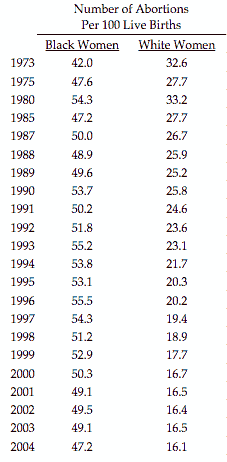This is the number of abortions in America by race, going back to 1973, through 2004:
Abortions for Black and White Women, 1973-2004

Source: Black Americans: A Statistical Sourcebook 2009. Based on information from the U.S. Department of Health and Human Services, Centers for Disease Control and Prevention
These numbers raise the question: why do black women have abortions at such a higher rate than white women?
The answer seems to be twofold: black women are more likely to have unintended pregnancies; and back women are more likely to feel they lack the maturity or resources to raise a child.
This chart, from the article Abortion and Women of Color: The Bigger Picture, shows the high correlation between the incidence of unintended pregnancies and abortions:

One comment I’ve heard on this subject is that, unfortunately, many pregnant black women use abortion as a kind of birth control. They never intended to have a child. But because they didn’t take effective steps to prevent the pregnancy on the “front end,” they wind up having to terminate the pregnancy on the back end.
Also of note, from the report Abortion and Women of Color: The Bigger Picture:
The abortion rate among women living below the federal poverty level ($9,570 for a single woman with no children) is more than four times that of women above 300% of the poverty level (44 vs. 10 abortions per 1,000 women). This is partly because the rate of unintended pregnancies among poor women (below 100% of poverty) is nearly four times that of women above 200% of poverty* (112 vs. 29 per 1,000 women).
Since African Americans have a higher poverty rate than white women, it’s not surprising that the abortion rate for black women is higher.
FYI, the most common reasons that women give for having an abortion are noted in the article Facts on Induced Abortion in the United States:
The reasons women give for having an abortion underscore their understanding of the responsibilities of parenthood and family life. Three-fourths of women cite concern for or responsibility to other individuals; three-fourths say they cannot afford a child; three-fourths say that having a baby would interfere with work, school or the ability to care for dependents; and half say they do not want to be a single parent or are having problems with their husband or partner.
There is, of course, a heated debate in America over the legality and morality of abortions. But everyone agrees that the best course of action would be to reduce the incidence of unintended pregnancies, since that appears to be the primary factor in the abortion decision. I’ll be doing some research on that subject (preventing pregnancies), and I hope to share those results with you all when I’m finished.